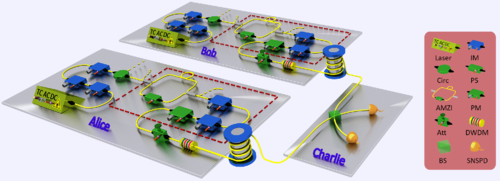
Encryption is critical in many aspects of modern life, however, perfectly secure communication can only be achieved using the strong correlations, or entanglement, between quantum objects. Quantum key distribution (QKD) makes it possible for two distant users to share a key with unconditional security.
PAN Jianwei at the University of Science and Technology of China (USTC) of Chinese Academy of Sciences and his colleagues have experimentally shown that a secure quantum protocol, known as measurement-device-independent quantum key distribution (MDIQKD), can be implemented over a distance of 404 km. The result breaks the previous MDIQKD record and paves the way for secure quantum communications between distant cities. This study was published on Physical Review Letters and was highlightened as Editor’s Suggestion.
Lengthening the distance and improving the key rate of QKD are vital issues in practical applications. In the past years, PAN’s team has achieved several significant results, however, these experiments failed to provide a satisfying performance in key rate. This time, they employed an optimized four-intensity decoy-state method, which was earlier proposed by WANG Xiangbin and his team from Tsinghua University.
PAN's team sent pulses of infrared photons through optical fibers with lengths between 102 and 404 km and optimized the MDIQKD scheme by tuning several parameters. For each length, researchers also determined the maximum speed by which cryptographic keys could be securely distributed. Compared with earlier experiments, they demonstrated a 500-fold increase in speed, reaching a key-distribution rate that would be sufficient to ensure encrypted voice transmission by telephone.
This record-breaking implementation of the MDIQKD method not only provides a new distance record for both MDIQKD and all types of QKD systems but also, more significantly, achieves a distance that the traditional Bennett-Brassard 1984 QKD would not be able to achieve with the same detection devices even with ideal single-photon sources. This work represents a significant step toward proving and developing feasible long-distance QKD.
This work was supported by Chinese Academy of Sciences, National Natural Science Foundation of China, Ministry of Science and Technology, Ministry of Education, government of Shandong Province, Jinan High-tech zone, etc.

Experimental setup for the MDIQKD system (Image by ZHANG Qiang, WANG Xiangbin and PAN Jianwei)

86-10-68597521 (day)
86-10-68597289 (night)

86-10-68511095 (day)
86-10-68512458 (night)

cas_en@cas.cn

52 Sanlihe Rd., Xicheng District,
Beijing, China (100864)

